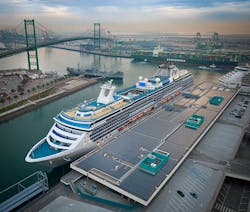Have We Fixed America’s Freight Infrastructure?
On the one-year anniversary of the Fixing America’s Surface Transportation (FAST) Act, the American Association of State Highway and Transportation Officials (AASHTO) and the American Association of Port Authorities (AAPA) released a national freight infrastructure report.
“Transportation matters more today than ever before, and this report serves as a blueprint for state DOTs, Congress and the new administration in Washington D.C. to address the critical freight infrastructure needs of our nation,” said AASHTO President and MaineDOT Commissioner David Bernhardt.
“One of our top priorities is to focus on intermodal freight capacity constraints and work collectively to improve the vital connections between rail, ports, intermodal facilities and the national surface transportation system necessary to meet the projected demand in population growth and freight movement over the coming decades,” Bernhardt added.
The report concludes that while states are making progress, improvements to critical freight infrastructure have not kept pace with current and future demands.
The report includes a number of key recommendations to leverage private-sector investment and move lawmakers to provide additional and ongoing funding resources outside of the Highway Trust Fund.
“Last year, AAPA released its initial The State of Freight survey report, which identified $29 billion in baseline investment seaport landside transportation infrastructure needs over the next decade to keep pace with rising freight volumes and increasing population density in metropolitan areas,” said Kurt Nagle, AAPA’s president and CEO.”
The survey found that 71% of states have state freight plans that they are actively working to make FAST Act compliant. Additionally, 57% of states have targeted more than 6,200 freight projects for inclusion in their state freight plans, while 35% have identified a combined $259 billion in costs for their state’s freight plan projects.
To help states plan sustainable investments in a national freight network, AAPA and AASHTO recommend several approaches, including:
- Having the U.S. Department of Transportation (USDOT) continue providing Highway Trust Fund (HTF) allocations to states for highway freight projects through the National Highway Freight program;
- Having the USDOT coordinate its Build America Bureau and freight advisory committees with state freight plans to better leverage private-sector investment;
- Requesting that Congress provide additional and ongoing funding resources outside of the HTF for the overall multimodal freight network in such a way it can supplement highway formula dollars and fund discretionary grant programs; and,
- Moving the Harbor Maintenance Tax (HMT) from discretionary to mandatory spending to enable all the revenues from HMT collections to be used for maintenance of deep draft navigation channels and providing more equity.
Of the 50 state departments of transportation and the District of Columbia’s, 12 have direct relationships with one or more ports in their state. Furthermore, 38 states are connected by navigable waterways and/or marine highway routes, which creates opportunities and obvious synergies for close DOT/port relationships.
As a center for economic and logistical activity, U.S. seaports support more than 23 million U.S. jobs and their cargo activities provide $321 billion in annual federal, state and local tax revenue. In 2014, cargo activities at U.S. deep-water ports generated $4.6 trillion in total economic activity, comprising about 26% of the nation’s economy, according to Martin Associates’ 2014 National Economic Impact of the U.S. Costal Port System, released in 2015.
